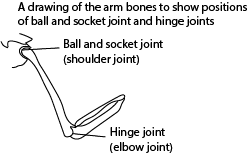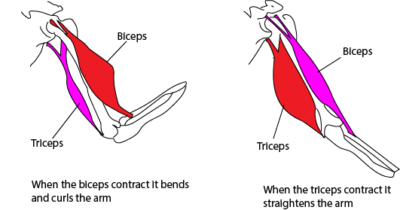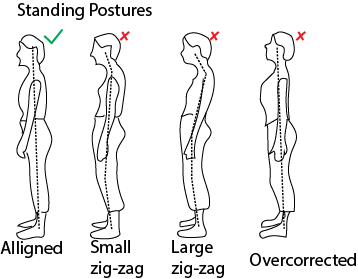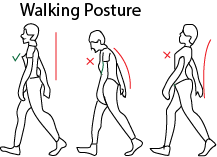
Locomotion and support -Upper primary science

Locomotion
One of the characteristic of living thing is movement.
Movement enable animals to look for food, mates and escape predators.
For movement to be possible there must be a form of support in animals it’s the skeletal tissue.
The skeletons
There are three types of skeleton
- Hydrostatic skeleton
Here support is provided by a fluid under pressure and it is found in round worms, earthworm.
- Exoskeleton
It is made of a hard cuticle protecting inner delicate tissues and also provides attachment for muscles
- Endoskeleton
It occurs in vertebrates, made of bone and cartilages.
It is internal and the muscles are outside
Skeleton
This is the framework of bone in the body

Human skeleton is divided into two parts
The axial skeleton forms the central axis of the body and includes the bones of the skull, vertebral column, and the thoracic cage
The appendicular skeleton is the portion of the skeleton of vertebrates consisting of the bones that support the appendages.
The appendicular skeleton includes the skeletal elements within the limbs, as well as supporting shoulder girdle pectoral and pelvic girdle.
BONES
Those are hard tissue that make up a skeleton
Functions of bone
- Protect delicate organs for example
- Skull protects the brain
- Rib cage protects the heart and lungs
- Vertebral column protect the spinal chord
- Long bones protect the bone marrow
- Give body shape for easy identification and a streamline shape reduce resistance during movement.
- Provide support
- Store Minerals Calcium
- Make blood cells
Skeletal structures of the fore arm

NB
- Tendons are tissues that join muscles to bones
- Ligaments are tissues that join bone to bone
Joints
A joint is a place where joint meet.
Types of Joint
- Pivot joint allows rotation movement e.g. neck
- Hinge joint allow movement of bone in two planes e.g. knee, elbow and finger joints
- Ball and socket joints at the shoulder and hip allow movement in many directions

Structure of synovial joint

Synovial fluid and cartilages are used to reduce friction at the joint.
Antagonistic muscles
Muscles responsible for movement by contracting and relaxing against the skeleton are referred to as antagonistic muscles, i.e., when one is contracted the other is relaxed. For example, in human arm when the biceps flex and the triceps extend the arm out.

Diseases of the skeletal system
Rickets
This are poorly formed bones due to lack of vitamin D in children
Polio
It is caused by the virus through contaminated water
It prevents proper development of muscles and bones
Polio can be prevent through immunization
Leprosy
It is caused by a bacteria
If untreated it causes loss of fingers.
It is treated in hospital
Disorders of the skeletal system
- Cuts and wounds
Cuts and wounds are mainly caused by sharp objects.
First aid for cuts
- Remove any clothing or debris on the wound. Don’t remove large or deeply embedded objects.
- Apply pressure using a clean cloth or bandage to reduce blood loss
- Apply a tourniquet to or 5-8cm above the wound if bleeding does not stop.
- Strain
This is an injury to the muscle or tendons due to stretch and overuse leading to a lot of pain; such as during playing football
- Sprains
A sprain is an injury in which a ligament is stretched, twisted or torn. They usually take place in joints. For example people can get sprains while walking down the step and accidentally miss a step.
- Pain in abdomen
It is caused by bad sitting posture. Sometimes we sit in a way which makes the muscles of the abdomen to get squeezed. When this happens, the muscles may develop pain.
- Back pain
It may be caused by bad sitting posture
- Fractures
A fracture is a cracked or broken bone. It can happen to any bone in the body.
Types of fractures
- Simple fractures, also called closed fractures, are broken bones that remain within the body and do not penetrate the skin.
- Compound fractures, also called open fractures, are broken bones that penetrate through the skin and expose the bone and deep tissues to the exterior environment.
Compound fractures are considered much more serious than simple fractures because they may be complicated by deep infections if pathogens enter the body through the wound.
Antibiotics are often used to prevent possible infections that may be associated with compound fractures.
First aid for fractures
- Reduce unnecessary movements with hands, a cushion, arm sling or a simple splint.
- Apply a cold pack on injured place
Posture
This is the way a person positions one’s body while sitting, standing or walking.
Bad postures lead to bent bones which leads to back and chest pain
Sitting posture



Good health hazard to maintain skeletal system
- Feed on a balanced diet
- Sit, stand and walk with correct posture.
- Avoid dangerous games like fighting that can cause injury.
- Avoid climbing trees
- Regular exercise
For revision questions and marking guide download PDF below:
Locomotion and support – Upper primary.docx
Sponsored by The Science Foundation College +256 753 802709
Compiled by Dr. Bbosa science + 256 778 633 682



Thanks for being a source of inspiration. Sports Fitness & Outdoor
Your content is a real gem. 500 ka redeem code
Plan your future with details from the MBBS Cutoff Of Private Medical Colleges in Sikkim.
Play the Raja Luck Game for an exciting and rewarding experience.